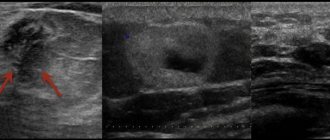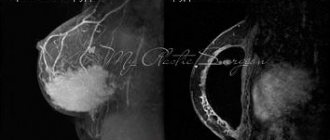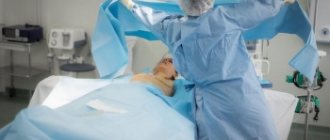Mammoplasty or breast surgery is one of the most popular and sought after operations.
- Why complications arise
- Types of complications Swelling of the chest or abdomen
- Seromas and hematomas
- Increased body temperature and inflammation
- Pain after mammoplasty
- Keloid scars
- Loss of skin sensitivity
- Capsular contracture
- Damage to the implant
- Breast deformities and their unnatural appearance
Every year, many women come to surgeons wanting to make their bust bigger. Intervention techniques, as well as the implants used, are constantly being improved. However, mammoplasty remains a full-fledged operation, after which, theoretically, complications may arise, especially if the patient ignores the recommendations of doctors during the rehabilitation period.
Why complications arise
Every woman planning breast surgery must study the list of possible complications. On the Internet you can find many unpleasant photos that cause serious doubts. That is why we pay special attention to the topic of problems that a plastic surgeon’s patient may encounter, as well as ways to prevent and treat them.
Doctors at the GALAXY Beauty Institute use the most modern equipment, high-quality medications and consumables, as well as modern, advanced implants that do not have the disadvantages of earlier models. All our services and consumables, including consultations with specialists before and after the intervention, implants, stay in the ward, anesthesia and compression garments, are included in the price. Still, complications after surgery are possible, although their risk is minimal.
Complications may occur due to:
- individual characteristics of the body and its unpredictable reactions;
- non-compliance with doctor's recommendations after surgery.
Even if a problem has arisen, it can be dealt with, especially if you address this issue right away.
IMPORTANT! If something bothers you after surgery, you need to see a doctor as soon as possible!
Causes of seroma formation after breast augmentation:
The causes of seroma can depend on both the plastic surgeon and the patient.
- rough operation with soft tissue trauma
- the cavity is too large for the implant without drainage
- non-compliance by the patient with the postoperative regimen
- premature increase in physical activity
- refusal to wear compression garments
In some cases, the cause of seroma cannot be determined; fluid accumulation begins for no apparent reason.
Seroma can form not only immediately after surgery, but also several months or even years after surgery. In this case, the reasons are most often:
- Injury. Any blow or chronic injury while performing physical exercise.
- Sudden hypothermia when swimming or performing bath procedures.
The formation of seroma occurs as a result of a reaction to injury or a foreign body. The soft tissue surrounding the implant produces fluid that accumulates around the implant. Normally, there may be a small amount of fluid, but it is never more than a few ml.
Types of complications
Complications can occur after any intervention on the mammary gland. They can be divided into two large groups:
- general - caused by the surgical intervention itself;
- specific - related to the implant and features of the anatomy of the mammary gland.
The first group includes the following problems:
- pain;
- swelling;
- seroma or hematoma;
- increased body temperature;
- keloid scars;
- changes in the sensitivity of the nipples or other areas of the breast;
- non-physiological discharge.
Specific complications include:
- capsular contracture;
- cracks or rupture of the implant;
- skin ripples (ripping);
- deformations of the mammary glands;
- rare complications.
Swelling of the chest or abdomen
Like pain, swelling of the breast and sometimes the abdomen after mammoplasty is a normal reaction to surgery. If it persists for more than three months or increases unexpectedly, a complication is said to have developed. Most often its cause is:
- wearing compression garments for insufficiently long periods;
- exposure to heat or ultraviolet radiation in the early postoperative period (hot shower, sauna, sun exposure, etc.);
- early physical activity.
IMPORTANT! Wearing a special bra, as well as following your doctor’s recommendations on physical activity, drinking regimen and salt intake will help speed up the resorption of swelling.
Seromas and hematomas
Seromas and hematomas are areas of fluid accumulation: tissue or blood. Unlike edema, they have more or less clear boundaries and, as a rule, are located in the lower part of the mammary gland, since they move there under the influence of gravity. The skin over the gray area has a normal color. When a hematoma develops, the accumulation of blood colors it in various shades of red, bluish or purple. During palpation, the woman will notice slight pain.
Small seromas and hematomas go away on their own. Larger lesions may fester. Only a doctor can correctly assess the degree of danger and prescribe treatment! Depending on the severity of the complication, drug therapy or drainage of the formation is prescribed. In this case, excess fluid is pumped out using a long needle.
Increased body temperature and inflammation
Fever is not uncommon after mammoplasty, especially if implants were installed during the process. This is a normal reaction of the body to tissue damage and the introduction of a foreign body. An increase in temperature up to 38 degrees in the first days after surgery is considered acceptable. It is necessary to sound the alarm if:
- The thermometer reading exceeded 38 degrees;
- fever persists for more than 14 days;
- the temperature dropped and then rose sharply.
As a rule, such changes indicate the development of an inflammatory process in the surgical area. It can also cause the following symptoms:
- redness of the breast;
- swelling of certain areas of the breast;
- sharp pain when touched;
- discharge of clear fluid or pus from the postoperative scar or from the nipple.
The body can react to inflammation very sharply, including nausea and vomiting, dizziness, skin rashes and even loss of consciousness. Such problems arise in very advanced cases, when patients ignore the doctor’s recommendations and do not contact him when the first signs appear.
Treatment is prescribed by a doctor depending on the severity of the process. In severe cases, repeated surgery to remove the implant is required.
Pain after mammoplasty
Pain itself is a natural reaction of the body to surgery. It is associated with tissue damage, as well as their stretching if an implant was installed. The intensity of sensations may vary, as it depends on the type of access, the volume of intervention, as well as the individual sensitivity of the body.
The pain is most severe in the first days, then gradually subsides. Most women note the complete disappearance of discomfort 2-3 weeks after the intervention. In this case, it cannot be called a complication.
If the pain suddenly becomes stronger, is accompanied by an increase in temperature or other symptoms, it indicates the development of a pathological process!
Keloid scars
Doctors at the GALAXY Beauty Institute make incisions so that the scars are not noticeable after healing. Normally, they are a thin, light line that is visible only upon careful examination. In some cases, the scar after healing remains pronounced, brightly colored and even bulges above the surface of the skin.
The cause of complications may be:
- individual tendency to form keloid scars;
- prolonged wound healing;
- excessive tissue tension around the healing incision;
- early use of absorbable creams.
In some cases, complications can be prevented with the help of ointments or with the help of a cosmetologist (for example, laser resurfacing).
IMPORTANT! If the patient already has keloid scars from other operations, it is better to refuse mammoplasty.
Loss of skin sensitivity
Loss of sensitivity in certain areas of the skin after mammoplasty is quite common. It involves cutting small nerves during surgery, especially if the incision is around the areola. In most cases, sensitivity is restored 2-6 months after the intervention. To speed up this process, doctors may prescribe B vitamins, antioxidants, or physical therapy.
Capsular contracture
This complication is associated with the development of scar tissue. This process, like many others, is natural, but in some women it is so pronounced that the implant becomes severely contracted and deformed. There are four degrees of capsular contracture:
- 1st degree: breasts are natural visually and to the touch;
- 2nd degree: there are no visual changes, a compaction is detected when palpated;
- 3rd degree: the shape of the mammary gland is changed, the tissue is hard to the touch;
- Grade 4: the gland is severely deformed and very dense to the touch, pain often occurs.
Severe contracture (grade 3-4) requires removal of the implant. Taking vitamin E, regular breast massage, and physical therapy will help reduce the risk of complications.
Damage to the implant
There are many rumors surrounding this complication. Previously, surgeons actively used prostheses filled with a solution of table salt or liquid silicone, which, indeed, cracked over time and spread inside the tissues. That is why it was recommended to change implants every five years.
Surgeons at the GALAXY Beauty Institute use only modern prostheses equipped with a durable two-layer shell. It is elastic and does not become damaged even after many years of use. The only reason for damage to the walls can be a strong physical impact due to injury, but even in this case, the silicone does not leave the cavity in which the prosthesis is located.
Breast deformities and their unnatural appearance
Selecting the shape and size of an implant is one of the important tasks of a plastic surgeon. At the GALAXY Beauty Institute, computer modeling is carried out, which allows you to visualize the approximate appearance of the bust after surgery.
IMPORTANT! If you do not take into account the age and anatomical features of a woman, the breasts may become deformed or simply look unnatural.
Here are the most common problems:
- sagging breasts due to loss of skin elasticity; the problem is solved by installing an implant under the muscle or performing a repeat operation with skin tightening;
- implant contouring for slender girls; the deficiency is eliminated by the lipofilling procedure;
- displacement of the implant when wearing compression garments for insufficiently long time; complication requires reoperation;
- too wide a distance between the glands or their visual fusion (“monoborax”, synmastia) due to incorrect selection of the implant or incorrect formation of the pocket; if desired, it can be eliminated by repeated surgery;
- skin ripples (ripping or “washboard effect”) - waves on the skin that change depending on the position of the body; the problem is solved by replacing the implant or breast lipofilling procedure.
Main signs of pathology
The symptoms of the pathology depend on the stage of its development and severity.
Common signs of complications:
- First degree breast contracture is considered the body’s normal defense against the implantation of a foreign object, the fibrous tissue in this case is elastic, its thickness and density do not exceed standard indicators;
- second degree - the fibrous tissue thickens, as a result of which the implant shifts; visually this is not noticeable, but upon palpation it can be clearly felt;
- third degree - breast deformation is noticeable, unpleasant sensations in the mammary glands are possible;
- the fourth degree is characterized by a loss of elasticity and softness of the breast, as well as its natural shape, there is a pronounced asymmetry of the mammary glands, and pain is possible.
Breast implant contracture in the later stages is diagnosed even by visual examination, but MRI and other studies are additionally prescribed.
*Photo of implant removal for capsular contarcture
What to do if you have symptoms of capsular contracture of the breast
First of all, you should immediately contact a specialist. The sooner a complication is identified, the easier it is to eliminate it and minimize negative consequences.
Treatment of breast pathology begins with the second degree. At this stage, you can limit yourself to simple procedures and medications. No surgical intervention is required.
Several methods are used for therapy, which are used in parallel with each other:
- Breast massage – relieves pain and swelling of tissues, increases skin elasticity, and prevents displacement of the endoprosthesis. The main thing is the correct technique, professional execution and regularity.
- Physiotherapy – optimal treatment results are demonstrated by ultrasound. A regularly performed procedure prevents tissue scarring, eliminates and prevents the development of inflammation, and stimulates healing.
- Taking vitamin E helps normalize hormonal levels, eliminates inflammation and swelling of the breast.
- Injections—potent medications are injected into the body. The substances in their composition relieve inflammation, stop the formation of the fibrous membrane, and initiate the healing of injured tissues.
As is easy to see, at the initial stage of the complication, the treatment is painless, with maximum comfort for the patient and without consequences. The same cannot be said about therapy at the third and fourth stages. At this stage, surgery is indispensable.
To remove the fibrous capsule (capsulotomy), both open intervention through an incision, and endoscopic or minimally invasive through punctures can be performed.
During the operation, the condition of the fibrous tissue is assessed, the capsule is removed, the endoprosthesis is installed in place or replaced.
Rare complications
Rare complications of mammoplasty include:
- allergy to the implant (manifested by skin rashes and swelling, requires removal);
- calcium deposits in the implant area (removed only if the defect is large);
- atrophy of gland tissue;
- damage to the milk ducts and inability to breastfeed after plastic surgery.
Breast surgery is a full-fledged operation that requires careful preparation, skillful execution, as well as careful adherence to the doctor’s recommendations during the rehabilitation period. In this case, the risk of complications will be minimal, which means that a beautiful bust will delight the patient all her life.











